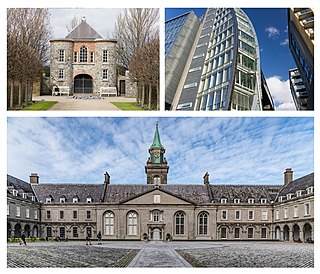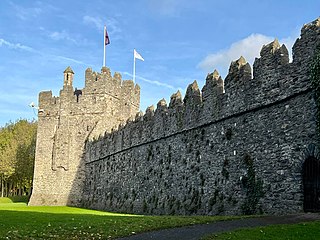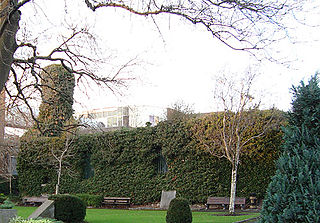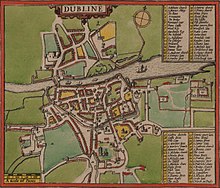
Saint Patrick's Cathedral in Dublin, Ireland, founded in 1191 as a Roman Catholic cathedral, is currently the national cathedral of the Church of Ireland. Christ Church Cathedral, also a Church of Ireland cathedral in Dublin, is designated as the local cathedral of the Diocese of Dublin and Glendalough.

Fingal is a county in Ireland. It is in the province of Leinster and is part of the Eastern and Midland Region. It is one of three successor counties to County Dublin, which was disestablished for administrative purposes in 1994. Its name is derived from the medieval territory of Scandinavian foreigners that settled in the area. Fingal County Council is the local authority for the county. In 2022 the population of the county was 330,506, making it the second most populated council in Dublin and the third most populous county in the state.

Kilmainham is a south inner suburb of Dublin, Ireland, south of the River Liffey and west of the city centre. It is in the city's Dublin 8 postal district.

Swords Castle is an early medieval castle located in Swords, Dublin. Originally built for the Archbishops of Dublin in the early 13th century near the Ward River, some of the castle estate had fallen into disrepair by the 14th and 15th centuries. At least partially occupied through the 16th and 17th centuries, the castle was used as a place of rendezvous by Anglo-Irish Catholic families during the 1641 Rebellion. The site was afforded protection as a national monument and placed under the guardianship of the Office of Public Works in the early 20th century. As of the late 20th and early 21st century, the site was subject to a program of "long-term phased restoration", and is partially opened for tours. The site is listed on Fingal County Council's Record of Protected Structures.
A county corporate or corporate county was a type of subnational division used for local government in England, Wales, and Ireland.

The Liberties is an area in central Dublin, Ireland, located in the southwest of the inner city. Formed from various areas of special manorial jurisdiction, separate from the main city government, it is one of Dublin's most historic working class neighbourhoods. The area was traditionally associated with the River Poddle, market traders and local family-owned businesses, as well as the Guinness brewery, whiskey distilling, and, historically, the textiles industry and tenement housing.

The River Poddle is a river in Dublin, Ireland, a pool of which gave the city its English language name. Boosted by a channel made by the Abbey of St. Thomas à Becket, taking water from the far larger River Dodder, the Poddle was the main source of drinking water for the city for more than 500 years, from the 1240s. The Poddle, which flows wholly within the traditional County Dublin, is one of around a hundred members of the River Liffey system, and one of over 135 watercourses in the county; it has just one significant natural tributary, the Commons Water from Crumlin.

The Archdiocese of Dublin is a Latin Church ecclesiastical territory or archdiocese of the Catholic Church located in the eastern part of Ireland. Its archepiscopal see includes the republic's capital city – Dublin. The cathedral church of the archdiocese is St Mary's Pro-Cathedral. Dublin was formally recognised as a metropolitan province in 1152 by the Synod of Kells. Its second archbishop, Lorcán Ua Tuathail, is also its patron saint.

There was a St. Kevin's Church in what is now St. Kevin's Park, Camden Row, Dublin, Ireland at least as far as the 13th century. After the Reformation, it became an Anglican church. The original church was replaced around 1750 by a new one, closed in 1912 and now in ruins. Both churches were dedicated to Kevin of Glendalough. There is also a Catholic St. Kevin's Church a short distance away on Harrington Street.
The Manor of Kilmainham was a manor encompassing the village of Kilmainham in County Dublin, Ireland, just outside the city of Dublin. It one of several manors, or liberties, that existed in Dublin after the arrival of the Anglo-Normans in the 12th century. The manors were town lands united to the city, but still preserving their own jurisdiction.

The Liberty of Thomas Court and Donore was one of several manors, or liberties, that existed in County Dublin, Ireland since the arrival of the Anglo-Normans in the 12th century. They were adjacent to Dublin city, and later entirely surrounded by it, but still preserving their own separate jurisdiction.

The Deanery of St Patrick was one of several manors, or liberties, that existed in Dublin, Ireland since the arrival of the Anglo-Normans in the 12th century. They were town lands united to the city, but still preserving their own jurisdiction. The Lord of the Manor was the Dean of St Patrick's Cathedral, Dublin. In the 19th century it was the smallest of the liberties of Dublin.
St. Nicholas Without is a former Church of Ireland parish church in Dublin, Ireland. For several hundred years the north transept of St. Patrick's Cathedral formed the church, with a wall separating it from the cathedral.

St. Nicholas Within is a former Church of Ireland parish church in Dublin city, Ireland. It was located at the corner of Nicholas St. and Christchurch Place, where part of its entrance may be seen next to the Peace Park. The term may also refer to the civil parish in the barony of Dublin City which was one of nine and a half baronies in the old County Dublin.
John Comyn, born in England, was Archbishop of Dublin, Ireland.
Hugh Inge or Ynge(c. 1460 – 3 August 1528) was an English-born judge and prelate in sixteenth century Ireland who held the offices of Bishop of Meath, Archbishop of Dublin and Lord Chancellor of Ireland.
The City Marshalsea was a debtor's prison in Dublin, Ireland. Debtors were imprisoned there by order of the Court of Conscience and Lord Mayor's Court of the county of the city of Dublin. The maximum debt was £10 in the Lord Mayor's Court, and 40s. (£2) in the Court of Conscience.
Clonmethan is a townland and a civil parish in the ancient barony of Balrothery West, Fingal in Ireland. It is bordered by the parishes of Palmerstown to the west, Grallagh to the north, Hollywood to the northeast, Westpalstown to the east, Killossery to the southeast, Killsallaghan to the south, and Greenoge, County Meath to the southwest.

Nicholas Queytrot (t) (c. 1475 – c. 1550), also called Nicholas Greytrot or Nicholas Coitrotte, was a wealthy merchant and citizen of Dublin city in the sixteenth century, who served one term as Mayor of Dublin in 1523-4.

The Four Courts Marshalsea was a prison in Dublin, Ireland until 1874. The keeper of the prison was the Marshal of the Four Courts, a role filled after 1546 by the Constable of Dublin Castle.
















